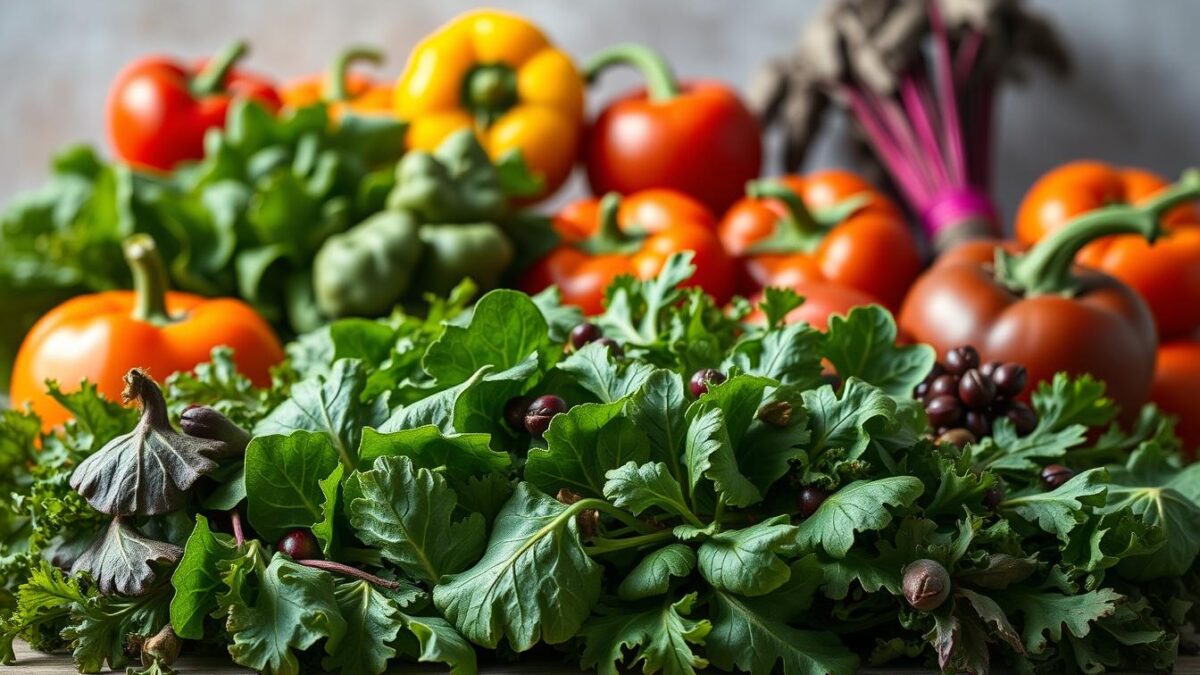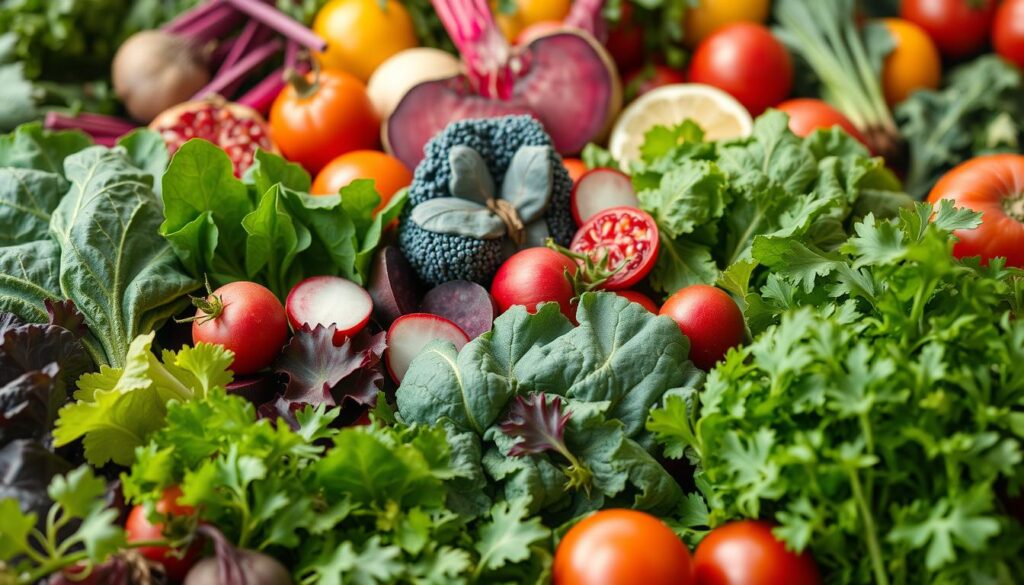
Natural Nitric Oxide-Boosting Foods You Should Include
If you want to boost your health, adding natural nitric oxide foods to your diet is a smart move. These foods increase nitric oxide levels, which improves blood flow and exercise performance. They can also help control blood pressure.
Ready to see how easy it is to make your diet nitric oxide-rich? Let’s dive into the foods that boost nitric oxide and how they can improve your health.
What is Nitric Oxide and Why is it Important?
Nitric oxide is a key signaling molecule in your body. Knowing about nitric oxide can greatly improve your health. It helps widen blood vessels, improving blood flow and lowering blood pressure.
Nitric oxide does more than just help your heart. It also boosts your immune system, helps your nervous system talk to itself, aids in breathing, and supports digestion. These roles help your body work better.
Having enough nitric oxide is key to avoiding diseases like heart disease and diabetes. By boosting nitric oxide levels, you support your body’s functions and promote health for the long term.
Health Benefits of Nitric Oxide
Boosting nitric oxide levels can bring many health benefits. Research shows that nitric oxide effects on health are positive. It improves heart health, boosts exercise performance, and enhances brain function.
Nitric oxide can lower cholesterol and blood pressure. This is good for the heart. It also helps with arthritis pain and diabetes complications.
The health benefits of nitric oxide go beyond physical health. It can lower the risk of dementia, which is important as people get older. Nitric oxide also improves skin health by boosting circulation and delivering nutrients and oxygen.
Adding nitric oxide and exercise to your routine can increase these benefits. Regular exercise boosts nitric oxide levels and enhances its health benefits. Understanding and using the health benefits of nitric oxide can greatly improve your life quality.
| Health Benefit | Description |
|---|---|
| Cardiovascular Health | Helps reduce cholesterol and lower blood pressure |
| Exercise Performance | Boosts endurance and recovery times in fitness routines |
| Brain Function | Linked to reduced risk of dementia and cognitive decline |
| Skin Health | Improves circulation, leading to healthier-looking skin |
| Chronic Pain Relief | Potential to alleviate pain from conditions like arthritis |
Natural Nitric Oxide Foods to Include in Your Diet
Adding natural nitric oxide foods to your diet can boost your health and athletic performance. Certain foods are known to increase nitric oxide levels, giving you a health advantage. Here are some top nitric oxide rich foods to add to your meals.
Beets
Beets are a top choice for boosting nitric oxide. They turn into nitric oxide in your body, improving blood flow and heart health. Try them raw in salads, roasted as a side, or blended into smoothies for a health boost.
Garlic
Garlic is more than just a flavor enhancer. It’s a natural source of nitric oxide, helping relax blood vessels and improve circulation. Adding fresh garlic to your meals can enhance taste and support nitric oxide production.
Leafy Greens
Leafy greens like spinach, kale, and arugula are great for nitric oxide levels. They’re full of vitamins and minerals and are high in nitrates. Add them to salads, smoothies, or as side dishes to get the most benefits.
Best Sources of Dietary Nitrates
Dietary nitrates are key for boosting your body’s nitric oxide levels. This is vital for heart health. You might be surprised to find that the best nitrate-rich foods aren’t just leafy greens. Celery, radishes, and carrots are also packed with nitrates.
These foods can greatly benefit your diet, adding both taste and health perks. To make the most of dietary nitrates, try adding more of these to your meals. A fresh salad with leafy greens and carrots is a great start. Snack on radishes or use celery sticks with dips for a healthy treat.

Food Groups Rich in Nitric Oxide Precursors
To boost nitric oxide levels, adding certain foods to your diet is key. Focus on foods rich in nitric oxide precursors. These help your body make nitric oxide, improving circulation and health. Nuts and seeds, along with citrus fruits, are top choices.
Nuts and Seeds
Nuts and seeds are tasty and good for nitric oxide. They have amino acids like L-arginine, which helps make nitric oxide. Here are some examples:
- Walnuts
- Almonds
- Chia seeds
- Flaxseeds
- Pumpkin seeds
Adding these to your meals is easy. Try them in salads, smoothies, or yogurt. They help your body make more nitric oxide.
Citrus Fruits
Citrus fruits are also great for nitric oxide. They’re full of vitamin C, which keeps nitric oxide levels up. Oranges, grapefruits, lemons, and limes are good choices. They’re good for your heart and add flavor to your meals.
Make citrus fruits part of your breakfast or snack time. Their taste and health benefits work well with nuts and seeds.
| Food Group | Nutritional Benefits | Ways to Incorporate |
|---|---|---|
| Nuts and Seeds | Rich in L-arginine and healthy fats | Salads, smoothies, yogurt |
| Citrus Fruits | High in vitamin C, stabilizes nitric oxide | Juices, snacks, salads |
By eating nuts and seeds and citrus fruits, you can boost nitric oxide naturally. This brings many health benefits.
How Antioxidants Enhance Nitric Oxide Production
Antioxidants are key in keeping nitric oxide levels stable in our bodies. Free radicals can quickly reduce nitric oxide, affecting our health. Eating foods high in antioxidants, like fruits and veggies, helps keep nitric oxide levels up.
Foods rich in vitamin C and E, like oranges and nuts, boost nitric oxide production. These nutrients protect nitric oxide from damage, helping our bodies use it well.
Eating a variety of colorful fruits and veggies is good for your health and nitric oxide levels. Try to include a mix of these in your meals every day for the best results.
| Food | Type of Antioxidant | Benefits |
|---|---|---|
| Oranges | Vitamin C | Boosts immune function and protects nitric oxide levels. |
| Strawberries | Ellagic Acid | Improves nitric oxide production and reduces inflammation. |
| Nuts (e.g., almonds) | Vitamin E | Stabilizes nitric oxide and protects against oxidative stress. |
| Spinach | Flavonoids | Enhances nitric oxide bioavailability for better circulation. |
Adding these vibrant, nutrient-rich foods to your diet supports your body’s nitric oxide management. This leads to better health and performance overall.
Best Ways to Incorporate Nitric Oxide-Boosting Foods
Adding nitric oxide-boosting foods to your diet can greatly improve your health. Start by adding these foods to every meal. Try blending leafy greens into your morning smoothies or adding roasted beets to your salads. Small changes can make a big difference in your nitric oxide levels.
Meal prepping is another great way to stay on track. It saves time and ensures you have healthy meals ready. Think about making a big batch of garlic hummus or a vibrant beet salad for the week.
For quick ideas, consider simple snacks like nuts or citrus fruits. They support nitric oxide production. Also, garlic in your cooking boosts nitric oxide levels and adds flavor.
By making these food choices, you’re on your way to better health. Enjoy these tasty and nutritious options every day.
The Role of Exercise in Increasing Nitric Oxide Levels
Regular exercise boosts nitric oxide levels naturally. It improves how well blood vessels work, which is key for making nitric oxide. Workouts that raise your heart rate and improve blood flow help make more nitric oxide.
One big plus of exercise is better blood flow. This means muscles get the nutrients they need and get rid of waste better. As you get better at working out, your body gets better at making nitric oxide. This helps you perform better and recover faster.
Trying different workouts can bring even more benefits. Running or cycling are great for making nitric oxide. Strength training helps muscles grow and get stronger. Sticking to a workout plan improves your health and boosts nitric oxide production.
Potential Risks and Considerations
While nitric oxide boosting foods have many benefits, there are risks to think about. Eating too much of foods like beets can cause digestive problems. People who are sensitive to nitrates might experience bloating or stomach pain. It’s important to eat these foods in moderation.
It’s also key to know where your nitrates come from. Processed meats, which often have added nitrates, can be harmful. Instead, choose natural sources like leafy greens and nuts. This way, you can avoid the risks of nitric oxide boosting.
Before changing your diet or starting supplements, talk to a healthcare provider. They can guide you on how to safely increase nitric oxide levels. This ensures you get the benefits without the risks.



